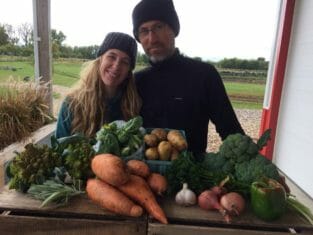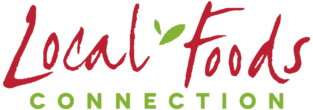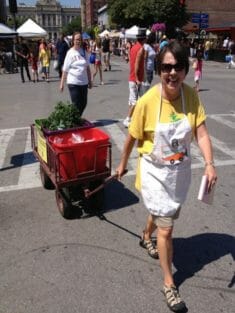Fostering Access to Local Food
Food insecurity exists in Iowa
Though 72 percent of Iowa’s land is dedicated to agriculture, the state isn’t immune to food security issues. Approximately 1 in 8 Iowans are food insecure, and 1 in 5 Iowa children are food insecure.
John Gilbert, Iowa Falls farmer, has been encouraging Practical Farmers of Iowa to bring farmers’ perspectives to the table at the World Food Prize’s annual Hunger Summit. John said, in one of our conversations, “The topic of food security needs to be a part of the whole local foods agenda. Bottom line, the needs in rural communities are probably greater than anyone wants to admit.”
Last year I attended the Summit for the first time, and former U.S. Secretary of Agriculture Mike Johanns echoed John’s sentiment. He said about food security: “Don’t forget agriculture. That’s where it all starts.”
 At this year’s Hunger Summit, Melissa Dunham, Grinnell farmer and volunteer executive director of Local Foods Connection, and Aubrey Alvarez, executive director of Eat Greater Des Moines, and I led a conversation on fostering access to local food. Many members in Practical Farmers of Iowa grow and distribute fresh food to their local communities. This local produce is vastly different than product found in grocery stores. Generally, grocery store produce is raised with efficiency, shelf life and durability in mind. Iowa farmers grow produce with focus on flavor, nutrition and quality. Substantially more labor goes into producing an Iowa-grown carrot versus a grocery store California-grown carrot.
At this year’s Hunger Summit, Melissa Dunham, Grinnell farmer and volunteer executive director of Local Foods Connection, and Aubrey Alvarez, executive director of Eat Greater Des Moines, and I led a conversation on fostering access to local food. Many members in Practical Farmers of Iowa grow and distribute fresh food to their local communities. This local produce is vastly different than product found in grocery stores. Generally, grocery store produce is raised with efficiency, shelf life and durability in mind. Iowa farmers grow produce with focus on flavor, nutrition and quality. Substantially more labor goes into producing an Iowa-grown carrot versus a grocery store California-grown carrot.
As the result of the divergence in these two production systems, the cost for Iowa farmers is higher, and they usually charge more to consumers. Even with these higher prices, many Iowa produce farmers struggle to make a profit. At the same time, their healthier, more delicious food is priced such that access is decreased for those who are food insecure.
Farmers work hard to provide healthy food to their communities because they are motivated to provide healthy food. Farmers within PFI have expressed the desire to provide this food for all, not just the financially privileged. In this conversation at the Hunger Summit, we discussed ways for farmers to realistically address food access. We talked about how farmers can be active players in improving food security without sacrificing potential profit, since they are themselves struggling to be financially viable.
Current efforts to increase food security via local food
The Bill Emerson Good Samaritan Food Donation Act protects individuals and organizations Protects from liability when they donate food in good faith to a non-profit organization should the product donated later cause harm to the recipient.
The Farm to Food Donation Tax Credit provides a tax credit equaling the lesser of $5,000 or 15% of the value of the food donated during the tax year for which the credit is claimed. The food must go to a registered Farm to Food Donation organization, and farmers must submit with their taxes a Farm to Food Tax Donation Credit Donation Receipt.
Double Up Food Bucks matches the value of Supplemental Nutrition Assistance Program (SNAP) purchases at farmers markets and grocery stores. If someone spends $10 at a participating farmers market, they will get $20 to spend on local food. This program provides access to fresh fruits and vegetables while supporting local farmers and economies.
Women, Infants and Children (WIC) and Senior Farmers Market Nutrition Programs provide coupons that can be exchanged for fresh locally grown fruits, vegetables and herbs at farmers markets and farmstands.
Local Foods Connection provides food-insecure clients access to local food in three ways:
- Credit to use with a farmer at the Grinnell Farmer’s Market,
- Credit on a wholesale purchasing account with a farm through agencies (MICA or Station Clubhouse are good examples of who receives food through this avenue), or
- Enrollment in a Community Supported Agriculture (CSA) group.
Local Foods Connection used to reside in Iowa City, but moved to Grinnell early 2017. An Iowa City food rescue champion in the room said, “Local Food Connections made a systemic impact on Iowa City. Even though it’s no longer based here, the community still puts high priority on local food in food security.”
Many farmers markets have programs where volunteers pick up unsold products to bring to food pantries, making donating easier for farmers. For instance, Table to Table collects food from Iowa City’s farmers market, and Des Moines Downtown Farmers Market operates Meals to the Market.
 Aubrey and Melissa stressed the importance of food education when providing fresh food. Many people who have faced food insecurity haven’t had the experience of preparing foods from scratch. Local Foods Connection provides a Thanksgiving box, along with a class that shows how to prepare a delicious meal.
Aubrey and Melissa stressed the importance of food education when providing fresh food. Many people who have faced food insecurity haven’t had the experience of preparing foods from scratch. Local Foods Connection provides a Thanksgiving box, along with a class that shows how to prepare a delicious meal.
August, with Feed Iowa First, said they been successful organizing gleaning, where volunteers go to farms and pick excess product. They have a strong volunteer base to help with this. Derek Nelson, who is director of sustainability at Kum & Go, used to work for DuPont. He said DuPont organizes employees to volunteer glean and donate food as well.
Northeast Iowa Food Bank quadrupled its cold storage when it moved in 2013 to be able to receive and donate more perishables. They more recently converted their clean and sort room to a temperature-controlled room so they can receive fresh produce in bulk, and sort for families to pick up.
PFI lifetime member Greg Lipes, former owner of Lipes Family Farm, would donate excess meat in his freezer to Table to Table. This was a good option to make room for new product. In addition, Greg asked his customers to donate money, and all proceeds went to purchase meat to provide to Table to Table. This is excellent, as Aubrey said, “Food pantries don’t need any more cakes or bread. What they really need is healthy protein!”
While several efforts are underway, there is much to be done to educate all parties how to amplify the focus and availability of healthy, local food for everyone in Iowa. The group identified ways that some current opportunities are prohibitive for farmers due to extra hoops to jump through, as well as the lack of awareness these opportunities exist. Hopefully additional conversations will lead to local food being a staple at food banks and other food access sites. If you have examples of how you’ve addressed the inclusion of local food in food access, please let me know!
Check this guest blog from Sarah Gilbert where she talks about how she addresses food access by volunteering at her local food pantry.
